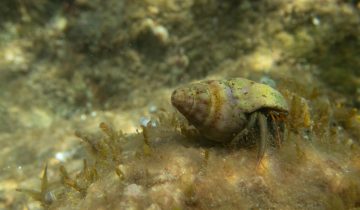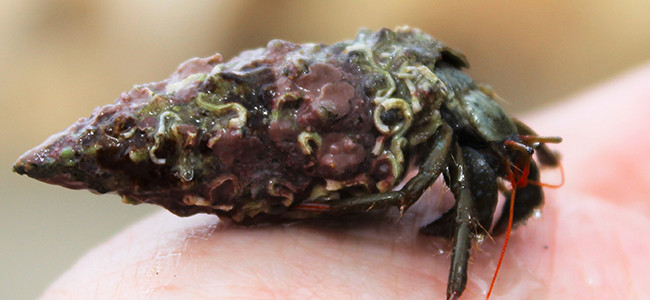Clibanarius erythropus, commonly known as the red-legged hermit crab, is a decapod crustaceans belonging to the family Diogenidae and the order Decapoda. The scientific name ‘Clibanarius‘ comes from the Latin ‘clibanus‘, meaning oven, referring to the shape of the shell that protects these crabs. ‘Erythropus‘ is derived from the Greek ‘erythros‘, meaning red, alluding to the distinctive color of its legs. It is distributed along the eastern Atlantic coast, from southern England to the Mediterranean Sea, preferring rocky habitats, tidal pools, and coastal areas rich in shelter and empty shells.
Morphologically, Clibanarius erythropus measures between 2 and 4 cm in length, though this may vary slightly depending on environmental conditions and shell availability. It has an asymmetrical exoskeleton, which is typical for hermit crabs, and inhabits empty gastropod shells to protect its soft abdomen. Its most distinctive feature is the bright red color of its legs, from which its scientific name is derived. The claws are unequal, with the right one typically larger than the left, aiding in identification. Compared to similar species like Pagurus bernhardus, Clibanarius erythropus is mainly distinguishable by the vivid coloration of its legs, whereas Pagurus bernhardus tends to have duller, brownish hues.
In terms of diet, Clibanarius erythropus is omnivorous and feeds on a wide variety of food sources. It primarily consumes organic detritus, small invertebrates, algae, and decaying matter. Its highly adaptable diet allows it to thrive in diverse coastal environments. As a scavenger, it plays an important role in nutrient recycling within the marine ecosystem by consuming dead material found in its surroundings.
Reproduction in Clibanarius erythropus is sexual, with distinct male and female individuals. Mating usually occurs during the warmer months of the year, from spring to summer, when the crabs are most active. After mating, the female carries the fertilized eggs in her abdomen, protected within the shell she inhabits. When the eggs hatch, the larvae are released into the water in a planktonic state, where they develop before settling on the seafloor and finding their first shell.
An interesting fact about Clibanarius erythropus is its interaction with other marine organisms through the shells it occupies. Depending on shell availability, these hermit crabs may compete with other hermits or even with live gastropods. Additionally, associations with epibionts such as algae or sponges growing on the shells are common, which can provide extra camouflage against predators.
Photos:

